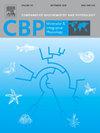Methods: Increasing feasibility of total blood cell count analysis in field studies: Effects of plastic tubes and storage duration
IF 2.2
3区 生物学
Q4 BIOCHEMISTRY & MOLECULAR BIOLOGY
Comparative Biochemistry and Physiology A-Molecular & Integrative Physiology
Pub Date : 2025-03-12
DOI:10.1016/j.cbpa.2025.111834
引用次数: 0
Abstract
Total red (RBC) and white (WBC) blood cell counts are highly informative haematological parameters, holding substantial potential for advancing ecological and evolutionary research and conservation efforts. Yet, their use in studies on wild bird populations is rare as blood samples need to be stored in fragile glass flasks and analysed on the day of collection, which poses significant challenges in field conditions. Here, we aimed to make total blood cell counts more accessible for field studies by assessing their reliability in blood samples collected in more durable plastic tubes and stored for varying periods of time. We used the zebra finch (Taeniopygia castanotis) as a model and aliquoted the collected blood samples into plastic tubes and glass flasks with Natt-Herrick's staining solution. When analysed on the day of collection, total RBC and WBC counts from the plastic tubes and glass flasks showed no difference and were highly repeatable. A subsequent repeated analysis of samples stored at 4–8 °C in plastic tubes for 18 months showed moderate repeatabilities of resultant blood cell counts that did not decrease over time. Together with the absence of linear trends in the results, consistent repeatabilities indicate that the total blood cell count information is effectively preserved in the long term. Overall, our study shows that blood samples can be collected in plastic tubes with Natt-Herrick's solution for analysis of total RBC and WBC counts. Moreover, long-term sample storage can be a viable option when immediate cell count analysis is impracticable, such as in field studies requiring sampling in remote locations. However, the moderate repeatability of cell counts in stored samples must be considered, particularly in within-population studies where relatively low biological variation is expected, which may require high analytical precision. These findings may facilitate more extensive application of total blood cell counts in wild bird research and conservation.

方法:提高全血细胞计数分析在实地研究中的可行性;塑料管和储存时间的影响。
红细胞(RBC)和白细胞(WBC)总数是信息量很大的血液学参数,在推动生态和进化研究及保护工作方面具有很大的潜力。然而,由于血液样本需要储存在易碎的玻璃瓶中,并在采集当天进行分析,这给野外条件带来了巨大挑战,因此在野生鸟类种群研究中很少使用。在此,我们旨在通过评估用更耐用的塑料管采集并储存不同时间的血样中总血细胞计数的可靠性,使野外研究更容易获得总血细胞计数。我们以斑马雀(Taeniopygia castanotis)为模型,将采集的血液样本等分到塑料管和玻璃烧瓶中,并加入纳特-赫里克染色液。在采集当天进行分析时,塑料管和玻璃烧瓶中的红细胞和白细胞总数没有差异,重复性很高。随后对塑料管中 4-8 ° C 下保存 18 个月的样本进行重复分析,结果显示血细胞计数的重复性适中,且不会随时间推移而降低。再加上结果中没有线性趋势,一致的重复性表明血细胞总数信息可以长期有效地保存。总之,我们的研究表明,使用纳特-赫里克溶液在塑料管中采集血液样本,可用于分析红细胞和白细胞总数。此外,在无法立即进行细胞计数分析的情况下,例如需要在偏远地区采样的实地研究中,长期储存样本也是一种可行的选择。不过,必须考虑到储存样本中细胞计数的中等重复性,尤其是在预期生物变异相对较低的种群内研究中,这可能需要较高的分析精度。这些发现可能会促进全血细胞计数在野生鸟类研究和保护中的更广泛应用。
本文章由计算机程序翻译,如有差异,请以英文原文为准。
求助全文
约1分钟内获得全文
求助全文
来源期刊
CiteScore
5.00
自引率
4.30%
发文量
155
审稿时长
3 months
期刊介绍:
Part A: Molecular & Integrative Physiology of Comparative Biochemistry and Physiology. This journal covers molecular, cellular, integrative, and ecological physiology. Topics include bioenergetics, circulation, development, excretion, ion regulation, endocrinology, neurobiology, nutrition, respiration, and thermal biology. Study on regulatory mechanisms at any level of organization such as signal transduction and cellular interaction and control of behavior are also published.

 求助内容:
求助内容: 应助结果提醒方式:
应助结果提醒方式:


